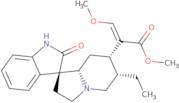
Product Information
- Corynoxan-16-carboxylic acid, 16,17-didehydro-17-methoxy-2-oxo-, methyl ester, (16E)-
- Methyl (16E)-16-(methoxymethylene)-2-oxocorynoxan-17-oate
- Spiro[3H-indole-3,1′(5′H)-indolizine]-7′-acetic acid, 6′-ethyl-1,2,2′,3′,6′,7′,8′,8′a-octahydro-α-(methoxymethylene)-2-oxo-, methyl ester, (αE,1′S,6′S,7′S,8′aS)-
- Spiro[3H-indole-3,1′(5′H)-indolizine]-7′-acetic acid, 6′-ethyl-1,2,2′,3′,6′,7′,8′,8′a-octahydro-α-(methoxymethylene)-2-oxo-, methyl ester, [1′S-[1′α,6′β,7′β(E),8′aα]]-
- spiro[3H-indole-3,1'(5'H)-indolizine]-7'-acetic acid, 6'-ethyl-1,2,2',3',6',7',8',8'a-octahydro-alpha-(methoxymethylene)-2-oxo-, methyl ester, (alphaE,3S,6'S,7'S,8'aS)-
Corynoxine is a pentacyclic triterpenoid that was isolated from the roots of Pueraria lobata. It has shown to have a variety of biological activities, such as receptor activity and autophagy induction. Corynoxine is a potent agonist for the human toll-like receptor 2 (TLR2) with an EC50 value of 1.0 µM and inhibits locomotor activity in mice at doses of 20 mg/kg. Corynoxine also has been shown to induce autophagy in rat liver cells by preventing the formation of protein aggregates, which are thought to be involved in Parkinson's disease. The chemical structure includes nitrogen atoms and five carbon rings, which form two hydrogen bonds.
Chemical properties
Technical inquiry about: 3D-FC74140 Corynoxine
If you want to request a quotation or place an order, please instead add the desired products to your cart and then request a quotation or order from the cart. It is faster, cheaper, and you will be able to benefit from the available discounts and other advantages.





